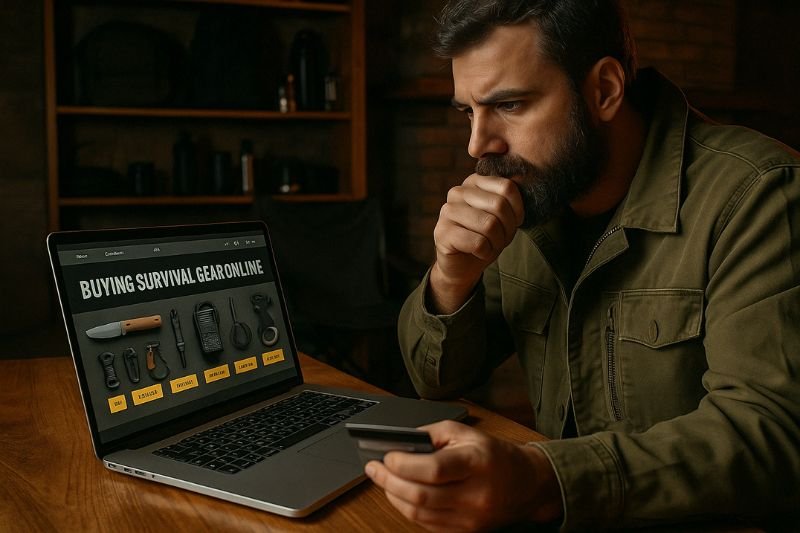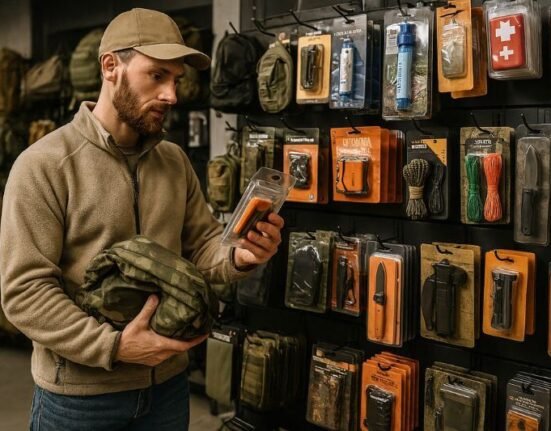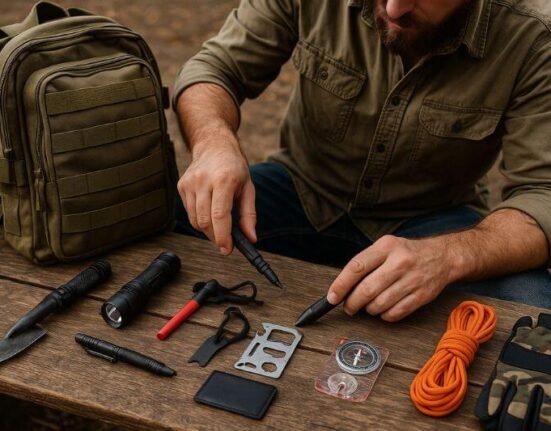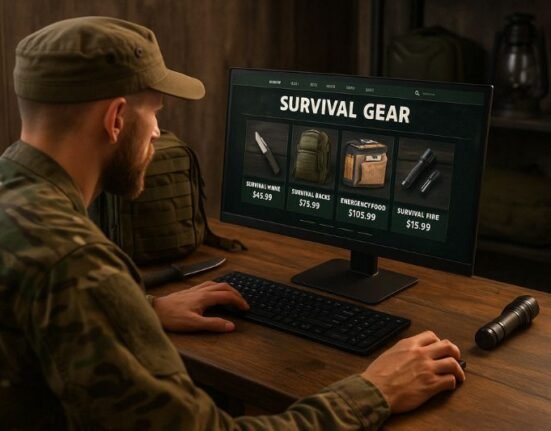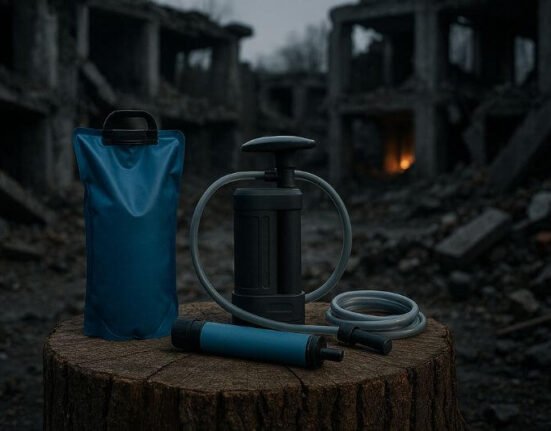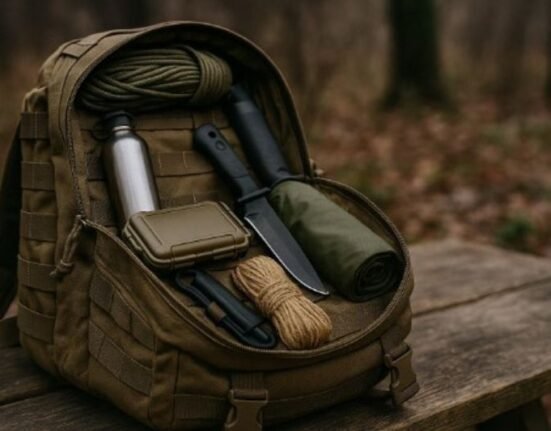In today’s digital world, buying survival gear has never been easier—or riskier. A few clicks, and your cart is full of knives, fire starters, radios, and tactical gadgets. But here’s the truth most websites won’t tell you: not all gear is built for survival. Some of it is barely built at all.
With thousands of options available, and many designed more for Instagram than emergencies, it’s easy to fall into expensive online gear traps. From unreliable tools to misleading reviews, making the wrong choice could leave you stranded with gear that fails when it matters most.
This article helps you make smarter decisions when choosing survival gear online—by asking the questions that real preppers use to separate gimmicks from life-saving tools.
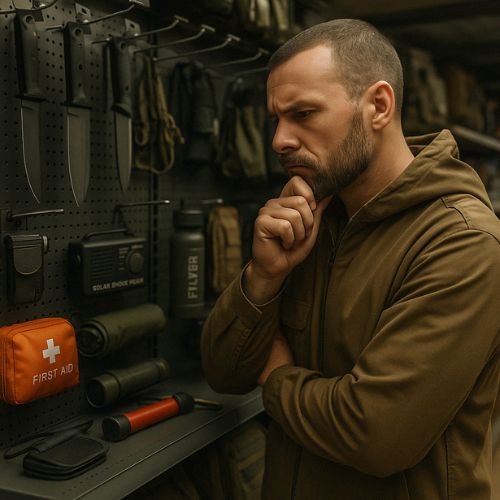
Why Buying Survival Gear Online Is Risky (If You’re Not Careful)
The Rise of Cheap, Untested Gear from Unknown Brands
Not all gear is created equal—especially when it’s mass-produced for online marketplaces. Many listings are dominated by copycat brands using stock photos, vague specs, and tactical buzzwords to lure new buyers.
These products often look similar to trusted gear but fail under stress:
- Knives with brittle blades
- Flashlights with fake lumen ratings
- Radios that stop working after one rainstorm
If you’re buying survival gear from a seller you’ve never heard of, pause. Without real testing, you’re just trusting their marketing.
🧠 Tip: A $10 multitool that breaks on first use isn’t a bargain—it’s a liability.
Reviews and Ratings: Helpful or Misleading?
One of the biggest pitfalls in online gear traps is trusting the 5-star rating system blindly. Many reviews are:
- Paid for (in exchange for free gear)
- Written after only unboxing
- Posted by non-preppers who never tested it
What you need are field-tested reviews—written by people who used the gear in the cold, in the dark, and under pressure. These voices are rare but essential in your prepper gear guide journey.
❌ If a review says “looks awesome!” but doesn’t explain real use—you’re flying blind.
Why Flashy Marketing Leads to Poor Field Performance
Let’s face it: marketing works. A video of a guy starting a fire with one hand and scaling a wall with a shovel/multitool hybrid looks cool. But cool doesn’t survive hypothermia.
A lot of bad gear decisions happen when aesthetics override practicality. Just because something is black, foldable, and covered in straps doesn’t make it survival-worthy.
Good gear is often simple, boring, and built like a tank.
That’s why buying survival gear online requires more skepticism than style appreciation. Always ask: Does it work wet, cold, and tired?
10 Critical Questions to Ask Before You Click “Buy”
Not every piece of gear that shows up in your search bar deserves a spot in your bug-out bag. Buying survival gear online requires more than just comparing prices and ratings—it demands strategic thinking. Before you click “Buy Now,” ask these 10 questions to avoid regret and gear failure when it matters most.
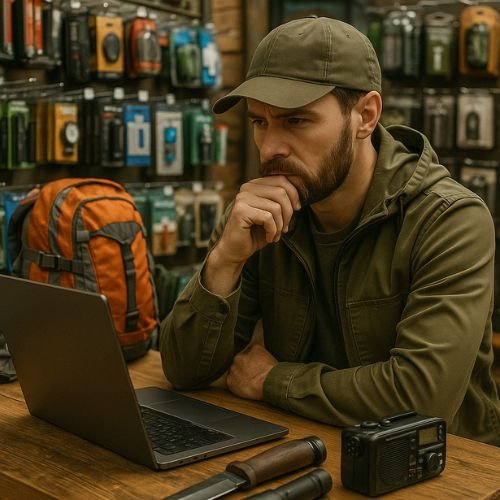
1. What Real Problem Does This Gear Solve?
Every piece of survival equipment must exist for one reason only: to solve a real problem you’re likely to face in a crisis. And yet, many online purchases are made based on novelty, trend, or panic.
Too often, people get caught up in the idea of prepping without understanding the functionality of the tools they’re adding to their cart.
Let’s take a simple example:
🔸 The problem: Starting a fire in cold, damp conditions
🔸 The wrong solution: Buying a combo keychain that includes a tiny flint wheel, compass, whistle, and thermometer.
🔸 The right solution: A dedicated ferro rod and waterproof tinder in a sealed container.
That little combo tool solves none of the above well. It feels “prepared,” but it’s just dead weight.
🧠 Ask yourself:
- Could I explain the exact situation where I’ll use this?
- Does this solve something my current gear doesn’t already address?
✅ Real-world gear selection starts with need. Cold? You need heat. Darkness? You need light. Flooding? You need water filtration. Gear must always be purpose-driven.
2. Has It Been Tested Under Real-World Conditions?
This is one of the most overlooked factors in choosing survival gear online.
Many tools work perfectly—on paper. But what happens when they’re exposed to mud, rain, fatigue, or adrenaline? What if you need to operate them with one hand while bleeding? What if you drop them in snow or ash?
Take the common “tactical shovel” example.
It folds. It saws. It starts fires. It stores fishing line. It has a bottle opener and glass breaker and compass. Sounds great, right?
But field testers found that:
- The lock mechanism jammed with sand and couldn’t reopen
- The saw teeth were too shallow to cut anything larger than a pencil
- The fire starter wore down after five strikes
- The aluminum threads stripped after 3 days in a real field test
This is classic bad survival gear: it passes online inspection but fails under pressure.
✅ What to do instead:
- Search YouTube and forums for real-world stress testing
- Read reviews by backcountry guides, SAR teams, or combat medics
- Look for signs of weather testing, drop testing, and long-term field use
🧠 If it hasn’t been tested by someone who’s relied on it under threat—it hasn’t really been tested.
3. What Materials and Construction Standards Are Used?
When you’re buying survival gear, you’re not just buying a tool—you’re buying the quality of its components. And most listings online give you almost nothing to work with.
They’ll say:
- “High-carbon steel” → But what kind? 1095? 3Cr13?
- “Water-resistant flashlight” → IPX2 or IPX8?
- “Durable plastic” → ABS? PC? Nylon?
That’s like saying a house is “made of wood” without telling you if it’s termite-ridden plywood or treated cedar.
Let’s look at a real example:
🔹 Two water filters, both look identical and are priced the same.
But one has:
- Hollow fiber membrane
- Meets EPA standards
- Filters down to 0.1 microns
- Compatible with hydration packs
- Tested by thousands in field conditions
The other:
- Says “removes bacteria and dirt”
- No micron rating
- No tests or certification
- No replacement parts
Which one belongs in your bug-out bag?
✅ Always look for specs like:
- Knife steel (1095, D2, VG10)
- Flashlight lumens, IP ratings
- Filter micron rating, NSF/EPA approval
- Firestarter ferrocerium vs. magnesium
- Battery type (AA/AAA vs proprietary)
🧠 Prepper Rule: If you don’t know what it’s made of, assume it won’t hold up when you need it.
4. Can I Maintain or Repair It Myself?
Imagine this: You’re 3 days into a bug-out. Your flashlight dies. The battery is sealed inside. You can’t open it. Your filter clogs. No way to backflush. Your multitool starts squeaking—until the pliers lock up.
Gear that can’t be repaired is a single-use trap—and you might not get that single use when it counts.
Ask:
- Can I field-strip this item without tools or manuals?
- Are replacement parts available and affordable?
- Can I clean, sharpen, oil, or reset it in the field?
Real-world examples: ✅ Good gear:
- Leatherman multitools with rebuild kits
- MSR Guardian water filter with field-cleanable cartridge
- Ferro rods with replaceable strikers
- Rechargeable flashlights that accept AA/USB/crank
❌ Bad gear:
- Knives with hollow plastic handles that can’t be tightened
- Plastic fire starters with short lifespan and no refills
- LED lanterns with sealed lithium-ion batteries
🧠 In survival, your tools are only as good as your ability to keep them working.
5. Is It Part of My Existing Survival System—or Just Extra Weight?
One of the biggest mistakes people make when buying survival gear online is assuming more is better.
A gear kit isn’t a trophy shelf—it’s a system. Every tool should interact with the rest of your loadout, not just float around.
Here’s a practical illustration:
🎒 Case 1: You buy a new stove that requires proprietary fuel. But all your current fuel is butane/propane mix. Now you’re carrying two types of fuel.
🧩 Case 2: You buy a small pot—but it doesn’t nest inside your pack’s cook set. So it rattles, takes up space, and gets left behind.
🎯 Case 3: You buy a compass. Great. But you’ve never used it with a map. It’s not marked in degrees, has no mirror, and doesn’t align with your navigational tools.
This is not choosing survival gear—this is collecting gear without purpose.
✅ Real preppers do this:
- Layout their system by scenario: bug-out, shelter-in-place, 72h, long-term
- Map tools to those systems
- Avoid redundancies unless they serve backup roles (e.g., two fire starters)
🧠 If the tool doesn’t fit your system, no matter how good it is—it’s dead weight.
6. Does It Work Without Electricity, Apps, or Rare Batteries?
In a grid-down event, nothing fails faster than technology-dependent gear. A flashlight that needs a USB-C charger becomes useless without power. A “smart compass” that requires an app becomes a dead weight in the woods. An emergency radio with no crank or solar backup is just a plastic brick.
Yet, these products dominate online marketplaces. They look sleek. They feel modern. But in reality, they’re traps—online gear traps that rely on infrastructure that might not be there when you need them most.
✅ Before buying survival gear, ask:
- Can this operate fully without electricity?
- Does it accept AA/AAA batteries I can find anywhere?
- Is there a manual or mechanical backup built-in?
🧠 Examples of good choices:
- Solar/crank radios with AM/FM, NOAA, USB out, flashlight
- LED headlamps that run on AAA batteries
- Magnetic compasses (not apps)
- Butane lighters + ferro rods (instead of USB plasma lighters)
🚫 What to avoid:
- Recharge-only flashlights with proprietary cables
- GPS-only navigation with no map backup
- Stoves that need electric ignition or apps to control fuel flow
Survival gear that needs apps is not survival gear.
7. What’s the Return Policy If It Arrives and Feels Wrong?
You’ve waited 7 days. Your “tactical survival tool” finally shows up. It looks cool—but it feels flimsy. The sheath rattles. The stitching is loose. The multitool barely opens. The fire striker barely sparks. What now?
If there’s no good return policy, you’re stuck with junk.
Many bad survival gear brands—especially those drop-shipping from overseas—either:
- Don’t accept returns
- Make the return process so hard you give up
- Force you to pay international shipping (more than the item’s value)
✅ Before clicking “Buy”:
- Check the return window (7/14/30 days?)
- See if returns are free or paid
- Look for satisfaction guarantees or trial periods
💡 Pro tip: Always test your gear within the return period. Set a reminder. Go in the backyard. Use it. Get it dirty. If it fails, send it back immediately.
🧠 If a tool can’t survive a day in the yard, it won’t last in a hurricane.
8. Are There Credible Field Reviews—or Just Affiliate Hype?
Amazon reviews lie. YouTube can lie too. So can blog posts with 15 affiliate links in the first paragraph.
What you want are field-proven reviews, from people who’ve actually carried the gear—in the woods, on the trail, during blackouts, in storms, or during real off-grid situations.
✅ How to spot a good review:
- Shows wear and tear on the gear
- Explains what broke or surprised them
- Gives context: “Used this after Hurricane Ida”, “Carried this for 90 days in Alaska”, etc.
- Compares it to other tools they’ve owned
🚫 Red flags:
- “Unboxing” with no actual use
- Generic praise like “Looks amazing!” or “Haven’t tested yet but I love it!”
- Stock images only
- Reviews posted within 24h of delivery
🧠 If no one’s used it in real-world conditions, you’ll be the test dummy. And that’s not how survival should work.
Use forums like BushcraftUSA, r/Survival, EDCforums, or YouTube channels that clearly test gear outdoors under stress. That’s your real prepper gear guide.
9. Is It Compatible with My Other Gear?
Compatibility is everything in survival systems. A tool isn’t just “good” on its own—it needs to fit your setup, your method, your environment.
Buying a water filter? Ask:
- Will it screw into my Nalgene or hydration bladder?
- Can it be gravity-fed or only suck-through?
Buying a flashlight?
- Does it mount to my MOLLE pack or helmet?
- Does it use the same battery type as my headlamp?
Buying a stove?
- Will it work with my current fuel (butane/propane/alcohol)?
- Does it nest inside my cook pot?
🎯 Example:
- A high-end filter with no standard threading might be great—but if it doesn’t connect to your bag or squeeze system, you’ll hate it in the field.
🧠 Every new piece of gear should enhance your setup, not isolate itself.
Buying survival gear isn’t about the tool. It’s about the system.
10. Could I Bet My Life on This Tool in an Actual Disaster?
Here’s the final and most important question.
Imagine this:
- It’s 2am.
- It’s raining hard.
- You’re tired, cold, and disoriented.
- The grid is down. Your flashlight flickers. You’re bleeding. You need to light a fire, purify water, and tend a wound.
Would you trust this tool?
That fire striker that looked cool on Instagram—would it work soaked in rain?
That tactical pen with a hidden blade—would it help stop a fall, or just snap?
That flashlight with 3 modes and no backup—would it die at the worst time?
If your answer is “maybe” or “I don’t know,” it’s not a survival tool.
🧠 True survivalists use this rule:
👉 If I wouldn’t trust it in a crisis, it doesn’t belong in my bag.
✅ That’s why seasoned preppers:
- Buy fewer things
- Buy slower
- Buy based on worst-case performance, not best-case appearance
🎒 You’re not prepping for comfort. You’re prepping for chaos.
Smarter Questions Lead to Stronger Survival
Buying survival gear online can feel overwhelming. With thousands of flashy tools, endless product pages, and conflicting reviews, it’s easy to fall into the trap of bad survival gear that looks great in your cart—but fails in the field.
But you’re not just building a collection. You’re building your last line of defense.
Every item you buy should:
- Solve a real-world problem
- Be field-tested and repairable
- Work without tech or power
- Fit into your existing survival system
- And above all… be something you can bet your life on
These 10 questions aren’t just a shopping checklist—they’re your mindset filter. They help cut through marketing noise, emotional decisions, and panic-driven gear hoarding.
🧠 Real preppers don’t just accumulate gear.
They choose it—slowly, deliberately, and based on what they’ve tested with their own hands, under real pressure.
So next time you’re buying survival gear, stop and ask: 👉 Does this help me survive? Or just help me feel like I might?
Because survival doesn’t care about style, brands, or “tacticool” looks.
It cares about what works—when nothing else does.









